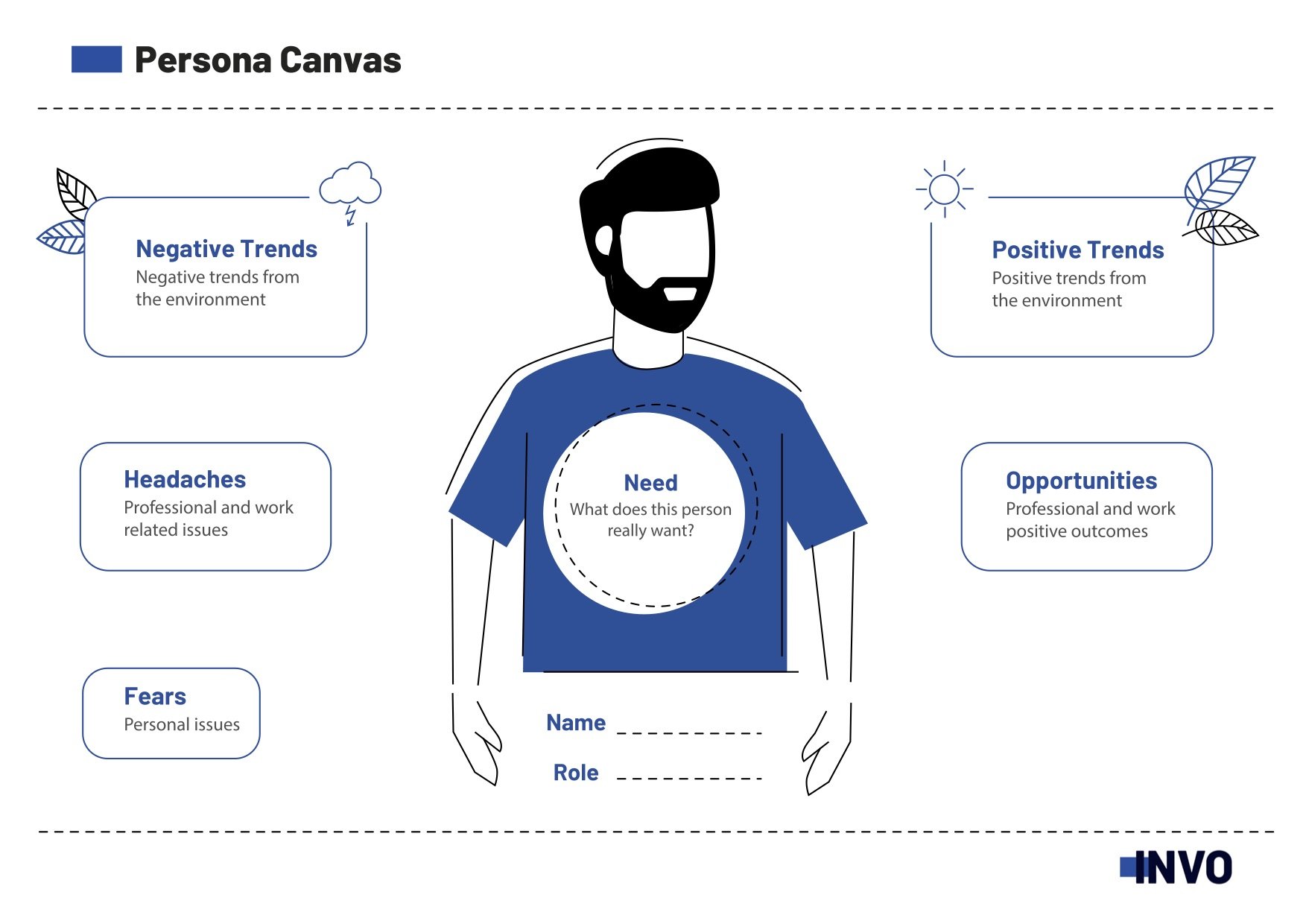In our “How To Use UX Techniques For Your Product’s Success” eBook, you will find free downloadable UX canvases and detailed descriptions on how to use them, even if you’re not a designer. In this article, we’re going to just focus on one of the canvases from the eBook – the User Persona Canvas. If you’d like to get an overview of more canvases like the Context Map or the Value Proposition – download our eBook.
WHEN TO USE:
- When working on anything customer-related
- When creating a new marketing/sales campaign
- When building an entirely new product or service
- When you feel like your team isn’t focused on the same goal
You’ve probably already heard of a thing we like to call a persona. It’s basically a representation of your target audience which we name and envision in order to understand them better. There’s several great benefits to creating a persona (or a few, if you have a diverse customer base). The first and most crucial one is that when you create this person on paper, give them a name and all, it will be easier for you and your team to empathize with them. It also ensures that each one of you is always on the same page whether it comes to working on a project and staying focused on a certain goal of creating a uniform marketing campaign. Let’s break down the User Persona Canvas:

1. Name & Role
The first thing to do is to name your persona and define their professional role. By doing this you will get more personal with the canvas-created person and if you’re creating a few personas, your team will have an easier time communicating about them when using specific names. The role is important because it will impact the next steps of the canvas.
PRO TIP: It’s better to work on a persona with your team. All of you combined have more insights and knowledge about your users than a single team member. During the workshop you can also use some of the ideation techniques explained above.
2. Needs
Now organize a brainstorm with your team and try to pinpoint what does this person really need and want. Don’t necessarily think of your product or service here. Focus on their values and their general needs like security, social status, being popular, feeling loved, being healthy etc. Those needs define their outlook on product and services they use and hugely impact their purchasing decisions.
3. Fears & Headaches
Now let’s move on to the next two sections on the canvas. They are essentially the same thing but Fears refer to the personal issues and Headaches refer to professional issues. First, let’s tackle Fears: try to list out your persona’s personal issues, fears and inhibitions. What is always in the back of their mind? Are their afraid of being criticized? Or maybe they feel a pressure to provide for their family? Try to really get deep and personal.
PRO TIP: When working on a User Persona, you can back yourself up with quantitative data you’ve gathered previously from tools like HotJar, Google Analytics or Ads Analytics. When you’re on the fence about something on the canvas, search for the answers in your database.
Now, for the Headaches. This section of the canvas is dedicated to the work-related issues in the persona’s life. Here’s where the defined role comes in very important. Depending on who your persona is and what their position is at the company they work for, their professional issues will be different. For a Project Manager, the issue might be time pressure and tight deadlines but for a Marketing Manager the issue might be a creative block or the lack of resources to implement their ideas.
Subscribe for exclusive access
4. Hopes & Opportunities
Again, as with Fears and Headaches, the Hopes and Opportunities represent positive aspects of the persona’s personal and professional life. With Hopes, you want to list their goals and hopes for the future. Everything they strive for and want to achieve, get or experience. This can mean many different things from buying an expensive car to starting a family or building a house. Opportunities, on the other hand, should be what they can and want to achieve in their work. Anything from being the employee of the month to getting promoted. Those two sections in the canvas focus on the positives in the personas future. It’s important to think about what they dream of or what are their professional goals because your product or service should ideally get them closer to achieving that.
5. Positive & Negative Trends
The last two sections of the User Persona Canvas are the Trends. Those two are more so focused on the persona’s environment rather than on what this person feels internally. With Positive and Negative Trends think about what impacts your persona is a good and in a bad way. Those things can include international events, general social trends and many other things like the ageing demographic, changes in the government, rise of veganism or digital transformation. For some companies, things like laws and regulations will also be important here, so think about this aspect of your persona’s environment. For example, if your persona is a business owner, think about what recent regulations may have impacted them and how.
If you’d like to download this canvas template and other templates to use with your team – download our eBook. And if you’re looking for an expert team to help you design your product – contact us and schedule a free product consultation.
